仁爱版八年级下册Unit8教案
- 格式:docx
- 大小:36.08 KB
- 文档页数:6
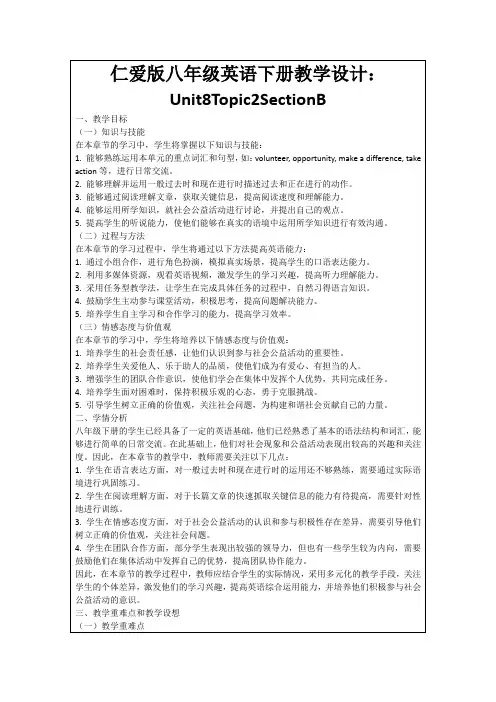
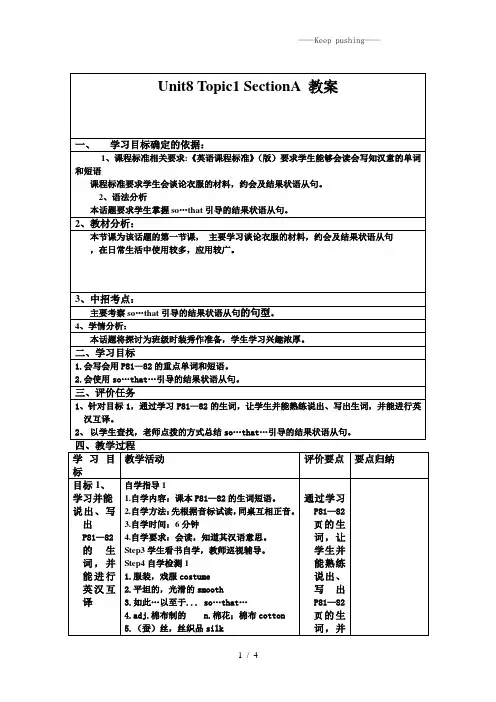

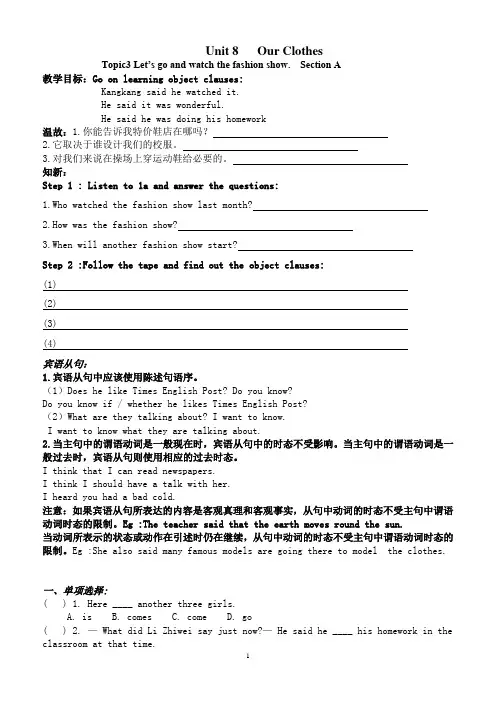
Unit 8 Our ClothesTopic3 Let’s go and watch the fashion show. Section A教学目标:Go on learning object clauses:Kangkang said he watched it.He said it was wonderful.He said he was doing his homework温故:1.你能告诉我特价鞋店在哪吗?2.它取决于谁设计我们的校服。
3.对我们来说在操场上穿运动鞋给必要的。
知新:Step 1 : Listen to 1a and answer the questions:1.Who watched the fashion show last month?2.How was the fashion show?3.When will another fashion show start?Step 2 :Follow the tape and find out the object clauses:(1)(2)(3)(4)宾语从句:1.宾语从句中应该使用陈述句语序。
(1)Does he like Times English Post? Do you know?Do you know if / whether he likes Times English Post?(2)What are they talking about? I want to know.I want to know what they are talking about.2.当主句中的谓语动词是一般现在时,宾语从句中的时态不受影响。
当主句中的谓语动词是一般过去时,宾语从句则使用相应的过去时态。
I think that I can read newspapers.I think I should have a talk with her.I heard you had a bad cold.注意:如果宾语从句所表达的内容是客观真理和客观事实,从句中动词的时态不受主句中谓语动词时态的限制。
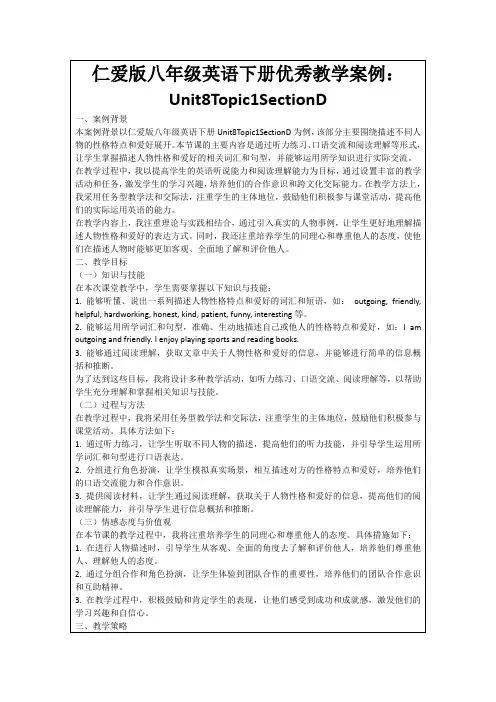
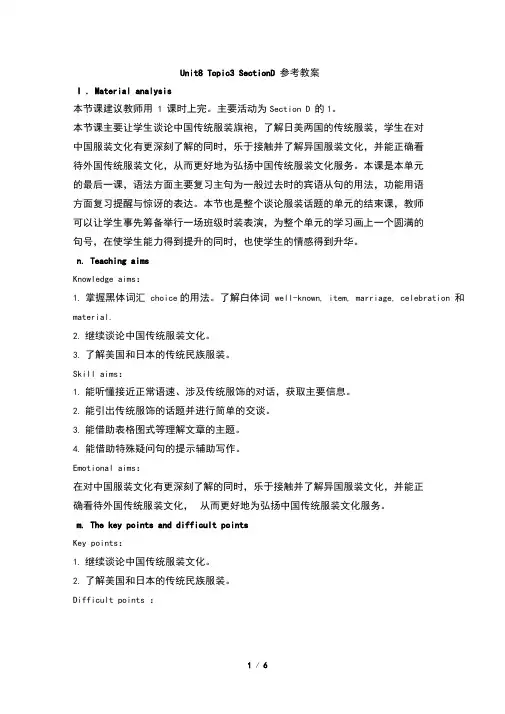
Unit8 Topic3 SectionD 参考教案I . Material analysis本节课建议教师用 1 课时上完。
主要活动为Section D 的1。
本节课主要让学生谈论中国传统服装旗袍,了解日美两国的传统服装,学生在对中国服装文化有更深刻了解的同时,乐于接触并了解异国服装文化,并能正确看待外国传统服装文化,从而更好地为弘扬中国传统服装文化服务。
本课是本单元的最后一课,语法方面主要复习主句为一般过去时的宾语从句的用法,功能用语方面复习提醒与惊讶的表达。
本节也是整个谈论服装话题的单元的结束课,教师可以让学生事先筹备举行一场班级时装表演,为整个单元的学习画上一个圆满的句号,在使学生能力得到提升的同时,也使学生的情感得到升华。
n. Teaching aimsKnowledge aims:1.掌握黑体词汇choice的用法。
了解白体词well-known, item, marriage, celebration 和material.2.继续谈论中国传统服装文化。
3.了解美国和日本的传统民族服装。
Skill aims:1.能听懂接近正常语速、涉及传统服饰的对话,获取主要信息。
2.能引出传统服饰的话题并进行简单的交谈。
3.能借助表格图式等理解文章的主题。
4.能借助特殊疑问句的提示辅助写作。
Emotional aims:在对中国服装文化有更深刻了解的同时,乐于接触并了解异国服装文化,并能正确看待外国传统服装文化,从而更好地为弘扬中国传统服装文化服务。
m. The key points and difficult pointsKey points:1.继续谈论中国传统服装文化。
2.了解美国和日本的传统民族服装。
Difficult points :写出短文介绍旗袍这一传统服饰。
IV.Learning strategies写作前根据特殊疑问句的提示制定好写作计划,然后根据写作计划中提供的要素完成写作任务。
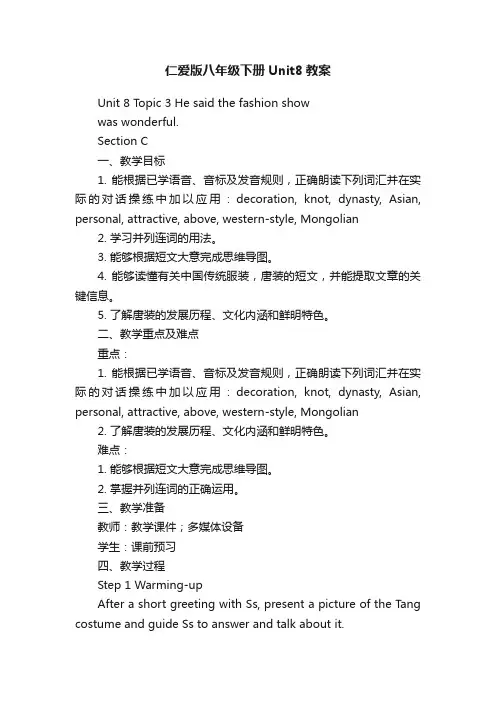
仁爱版八年级下册Unit8教案Unit 8 Topic 3 He said the fashion showwas wonderful.Section C一、教学目标1. 能根据已学语音、音标及发音规则,正确朗读下列词汇并在实际的对话操练中加以应用:decoration, knot, dynasty, Asian, personal, attractive, above, western-style, Mongolian2. 学习并列连词的用法。
3. 能够根据短文大意完成思维导图。
4. 能够读懂有关中国传统服装,唐装的短文,并能提取文章的关键信息。
5. 了解唐装的发展历程、文化内涵和鲜明特色。
二、教学重点及难点重点:1. 能根据已学语音、音标及发音规则,正确朗读下列词汇并在实际的对话操练中加以应用:decoration, knot, dynasty, Asian, personal, attractive, above, western-style, Mongolian2. 了解唐装的发展历程、文化内涵和鲜明特色。
难点:1. 能够根据短文大意完成思维导图。
2. 掌握并列连词的正确运用。
三、教学准备教师:教学课件;多媒体设备学生:课前预习四、教学过程Step 1 Warming-upAfter a short greeting with Ss, present a picture of the T ang costume and guide Ss to answer and talk about it.1. What is she wearing?2. What do you think of her dress?3. How does she look like?【设计意图】复习回顾上节课的内容,为本课继续了解中国传统民族服装唐装特点做好准备。
Step 2 Pre-reading1. Present some pictures and guide Ss to answer the questions. Then learn some new words and some sentences.【设计意图】创设语境,引入新的词汇、句子学习,为下面的阅读扫清词汇障碍。
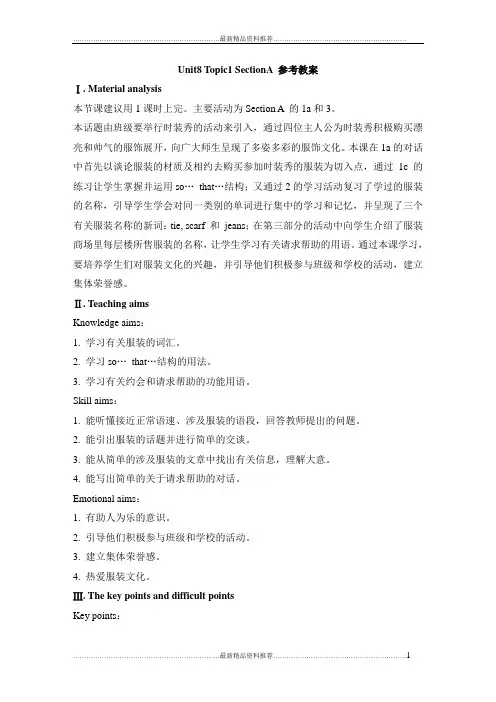
Unit8 Topic1 SectionA 参考教案Ⅰ. Material analysis本节课建议用1课时上完。
主要活动为Section A 的1a和3。
本话题由班级要举行时装秀的活动来引入,通过四位主人公为时装秀积极购买漂亮和帅气的服饰展开,向广大师生呈现了多姿多彩的服饰文化。
本课在1a的对话中首先以谈论服装的材质及相约去购买参加时装秀的服装为切入点,通过1c 的练习让学生掌握并运用so…that…结构;又通过2的学习活动复习了学过的服装的名称,引导学生学会对同一类别的单词进行集中的学习和记忆,并呈现了三个有关服装名称的新词:tie, scarf 和jeans;在第三部分的活动中向学生介绍了服装商场里每层楼所售服装的名称,让学生学习有关请求帮助的用语。
通过本课学习,要培养学生们对服装文化的兴趣,并引导他们积极参与班级和学校的活动,建立集体荣誉感。
Ⅱ. Teaching aimsKnowledge aims:1. 学习有关服装的词汇。
2. 学习so…that…结构的用法。
3. 学习有关约会和请求帮助的功能用语。
Skill aims:1. 能听懂接近正常语速、涉及服装的语段,回答教师提出的问题。
2. 能引出服装的话题并进行简单的交谈。
3. 能从简单的涉及服装的文章中找出有关信息,理解大意。
4. 能写出简单的关于请求帮助的对话。
Emotional aims:1. 有助人为乐的意识。
2. 引导他们积极参与班级和学校的活动。
3. 建立集体荣誉感。
4. 热爱服装文化。
Ⅲ. The key points and difficult pointsKey points:1. 学习有关服装的词汇。
2. 学习so…that…结构的用法。
3. 学习有关约会和请求帮助的用语。
Difficult points:尝试用英语写出简单的关于请求帮助的对话。
Ⅳ. Learning strategies1. 集中记忆同类别的词汇。
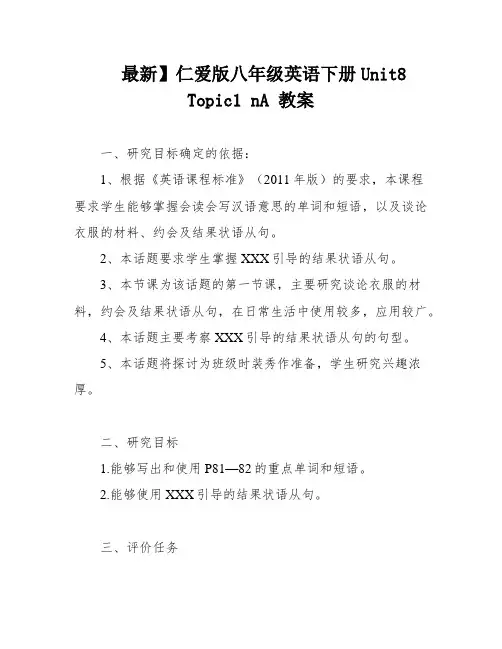
最新】仁爱版八年级英语下册Unit8Topic1 nA 教案一、研究目标确定的依据:1、根据《英语课程标准》(2011年版)的要求,本课程要求学生能够掌握会读会写汉语意思的单词和短语,以及谈论衣服的材料、约会及结果状语从句。
2、本话题要求学生掌握XXX引导的结果状语从句。
3、本节课为该话题的第一节课,主要研究谈论衣服的材料,约会及结果状语从句,在日常生活中使用较多,应用较广。
4、本话题主要考察XXX引导的结果状语从句的句型。
5、本话题将探讨为班级时装秀作准备,学生研究兴趣浓厚。
二、研究目标1.能够写出和使用P81—82的重点单词和短语。
2.能够使用XXX引导的结果状语从句。
三、评价任务1、通过研究P81—82的生词,让学生能够熟练说出、写出生词,并能进行英汉互译。
2、以学生查找和老师点拨的方式总结XXX…引导的结果状语从句。
四、教学过程目标1、自学指导11.让学生自学课本P81—82的生词短语,先根据音标试读,同桌互相正音。
2.自学方法:学生自己研究,教师巡视辅导。
3.自学时间:6分钟4.自学要求:学生能够熟练说出、写出生词,并能进行英汉互译。
自学指导21.让学生听录音和扫读课本81页1a。
2.自学方法:学生自己研究,教师巡视辅导。
3.自学时间:5分钟4.自学要求:学生能够听懂1a的内容,完成1b。
朗读1a,完成1c。
目标2、自学指导31.让学生自学XXX…引导的结果状语从句。
2.自学方法:学生自己研究,教师巡视辅导。
3.自学时间:7分钟4.自学要求:学生能够掌握so…that…引导的结果状语从句的用法和句型结构。
五、课堂练1.让学生用P81—82的生词和短语造句。
2.让学生用XXX…引导的结果状语从句造句。
六、作业1.完成课本P82的练。
2.写一篇短文,使用P81—82的生词和短语,并包含XXX…引导的结果状语从句。
七、教学反思本节课通过让学生自学P81—82的生词和短语、XXX…引导的结果状语从句,让学生更好地掌握了这些知识点。
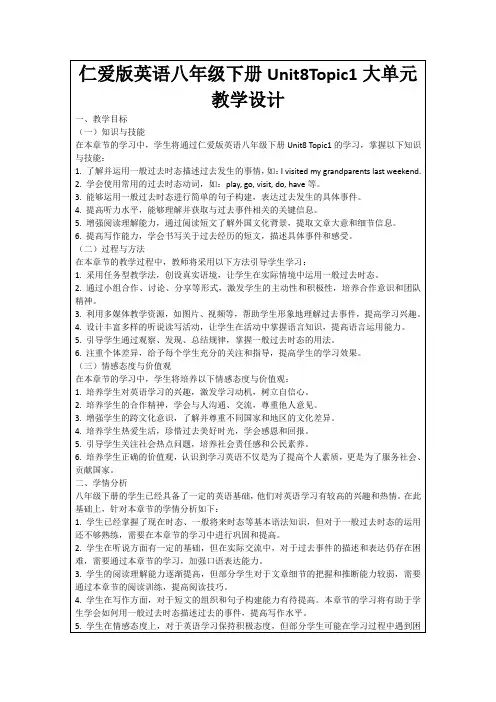
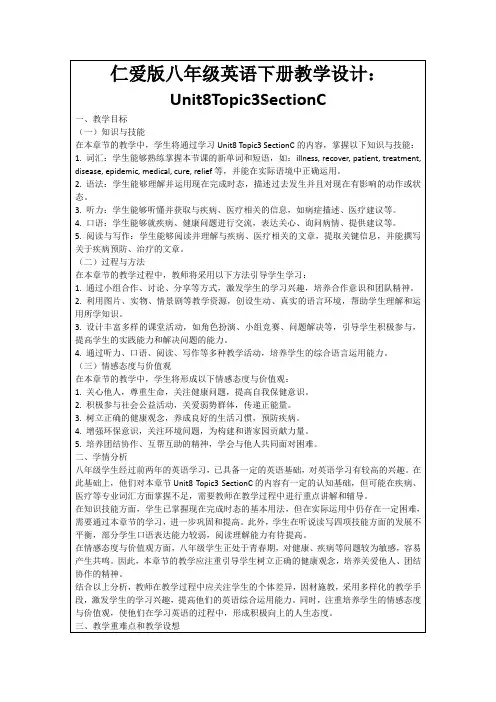
Unit 81. so..., so…that…, so that…句型I like it a lot, so my father bought it for me.My old coat are so short that I want to buy some new ones.I want to buy a windbreaker so that I will look more handsome.2. It is+adj.+that clauseIt is important that you wear suitable clothes on every occasion.It is necessary that people wear suitable clothes.3. Object clauses(Ⅲ)She asks what materials they should choose.Can you tell me what I should wear here?Could you tell me where the special shoes are?4. Object clauses(Ⅳ)He said the fashion show was wonderful.Kangkang said he was doing his homework.1.服装的类型。
I’d like these cotton pants and this T-shirt.I’d like to buy a silk hat and a woolen dress.2.不同场合的着装及不同体形的穿着。
You should wear a suit.If a slim girl enters your shop, you’d better advise her to wear clothes in warm colors.3.中国传统服装文化和异国传统服装文化。
Unit 8 Topic 2 We can design our ownuniforms.Section B一、教学目标1. 能根据已学语音、音标及发音规则,正确朗读下列词汇并在实际的对话操练中加以应用:lady, gentleman, sale, guest, kind-hearted, menu, soft drink, beer, bill, corn, salad2. 继续学习并掌握特殊疑问词引导的宾语从句和“It’s +形容词+that +从句”句型。
3. 能够在口语活动中做到语音、语调基本正确。
4. 能够识别不同句式的语调并根据语调变化体会句子意义的变化。
5. 能够听懂不同的场所应得体着装的对话,并且能够提取关键信息。
6. 能够运用正确的表达方式向别人提出合理的建议。
二、教学重点及难点重点:1. 能根据已学语音、音标及发音规则,正确朗读下列词汇并在实际的对话操练中加以应用:lady, gentleman, sale, guest, kind-hearted, menu, soft drink, beer, bill, corn, salad2. 继续学习并掌握特殊疑问词引导的宾语从句和“It’s +形容词+that +从句”句型。
难点:通过改变语调来表达不同的语气。
三、教学准备教师:教学课件;多媒体设备学生:课前预习四、教学过程Step 1 RevisionAfter a short greeting with Ss, ask several pairs of Ss to act out the conversation in 1a in Section A to review.【设计意图】引导学生快速回归课堂学习状态,回顾上节课的内容。
Step 2 Pre-listening1. Look at pictures and guess what his job is. Then learn some new words.T: Can you guess his job according to his uniform?【设计意图】通过看图猜职业的活动,激活学生的思维模式,同时学习新词汇,为新课的学习扫清词汇障碍。
复习目标1:能够熟练掌握本话题的单词及短语,并能灵活运用。
复习指导一:复习内容:课本P81----P88单词,完成下题。
复习方法:朗读记忆,同桌互查复习时间:5分钟复习要求:通过朗读记忆单词,加深重点单词的拼写及用法。
根据汉语写出英语平坦的;光滑的__________ 丝,丝织品__________女用手包______ 买得起________领带,纽带___________ 毛衣___________围巾__________ 口袋__________达到目的,成功___________ 顾客__________生意公事_________ 讨论____________复习检测一:(A)根据汉语或首字母提示填空。
1. This __________ (丝) blouse is nicer than the cotton one.2. The s__________ around the girl’s neck makes her more lovelyand beautiful.3. The girl opened her h__________ and took out a postcard with aBritish stamp on it.4. The young man in a leather jacket looks h__________. Manygirls like him.5. Grandpa Wang lives a __________ (简易的) life. He neverwastes anything.(B)根据句意,用括号内所给单词的正确形式填空。
6. China __________ (success) in sending Shen Zhou-10 into spaceon July 11th, 2013.7. If you want to be __________ (slim), please eat more vegetablesand less meat.8. Miss Wang __________ (wear) a pair of sunglasses when I mether yesterday.9. The pink T-shirt makes the girl __________ (live) andeasy-going.10. As the old _________ (say) goes, “Time waits for no man!”重点单词的识记不仅要求会读,拼写,最重要的是灵活运用。
Unit8 Topic2 SectionA 参考教案Ⅰ. Material analysis本节课建议教师用1-2 课时上完。
主要活动为Section A 的1a 和2a。
民主的师生关系和着装艺术是本话题的一个亮点:本话题由师生一起设计校服引入,继而谈论制服的重要性和不同场合的着装艺术,在呈现这些趣味话题的同时巧妙地融合了疑问词引导的宾语从句,以及句型It’s + adj. + that…和It’s + adj. + (for sb. ) to do sth.。
本课在1a 的对话中首先以师生一起谈论设计校服为切入点,通过1c 和3 的练习让学生学习运用由疑问词引导的宾语从句;又通过2 的学习活动,引导学生在学习和运用中体会when 引导宾语从句时和when 引导时间状语从句时的不同用法。
同时通过本课的学习,呈现了句型It’s + adj. + that…和It’s + adj. + (for sb. ) to do sth.的用法,要求学生能够学以致用。
Ⅱ. Teaching aimsKnowledge aims:1. 学习由疑问词引导的宾语从句。
2. 学习句型It’s + adj. + that…和It’s + adj. + (for sb. ) to do sth.。
3. 谈论制服。
Skill aims:1. 能听懂接近正常语速、涉及校服设计和制服穿着的语段,回答老师提出的问题。
2. 能就校服设计的话题进行简单的交谈。
3. 能从简单的文章中找出有关信息,理解大意。
4. 能根据对话简单地写出关于穿着制服的重要性的短文。
Emotional aims:1. 有参与校服设计的热情。
2. 能在小组活动中积极与他人合作,相互帮助,共同完成学习任务。
Ⅲ. The key points and difficult pointsKey points:1. 学习由疑问词引导的宾语从句。
2. 学习句型It’s + adj. + that…和It’s + adj. + (for sb. ) to do sth.。
Unit 8 Topic 3 He said the fashion showwas wonderful.Section C一、教学目标1. 能根据已学语音、音标及发音规则,正确朗读下列词汇并在实际的对话操练中加以应用:decoration, knot, dynasty, Asian, personal, attractive, above, western-style, Mongolian2. 学习并列连词的用法。
3. 能够根据短文大意完成思维导图。
4. 能够读懂有关中国传统服装,唐装的短文,并能提取文章的关键信息。
5. 了解唐装的发展历程、文化内涵和鲜明特色。
二、教学重点及难点重点:1. 能根据已学语音、音标及发音规则,正确朗读下列词汇并在实际的对话操练中加以应用:decoration, knot, dynasty, Asian, personal, attractive, above, western-style, Mongolian2. 了解唐装的发展历程、文化内涵和鲜明特色。
难点:1. 能够根据短文大意完成思维导图。
2. 掌握并列连词的正确运用。
三、教学准备教师:教学课件;多媒体设备学生:课前预习四、教学过程Step 1 Warming-upAfter a short greeting with Ss, present a picture of the Tang costume and guide Ss to answer and talk about it.1. What is she wearing?2. What do you think of her dress?3. How does she look like?【设计意图】复习回顾上节课的内容,为本课继续了解中国传统民族服装唐装特点做好准备。
Step 2 Pre-reading1. Present some pictures and guide Ss to answer the questions. Then learn some new words and some sentences.【设计意图】创设语境,引入新的词汇、句子学习,为下面的阅读扫清词汇障碍。
2. Look at the pictures in 1a and match the words with them. And then guide Ss to discuss in groups about the Tang costume.T: There are many Chinese-style decorations such as dragons, Chinese characters, silk knots and so on. People call it Tang costume because people in Tang wore them.【设计意图】通过图词匹配,巩固新学的词汇,训练学生进行读前讨论,为后面的阅读奠定基础。
Step 3 While-reading1. Read 1a and complete the diagram.T: A mind map can help you understand or express ideas more easily, clearly and logically.【设计意图】培养学生利用“思维导图”帮助理解短文的阅读策略。
2. Read 1a again and answer the questions.T: Read the questions first before reading and think what you should pay attention while reading.【设计意图】训练学生带着问题有针对性地阅读,提升阅读效率。
Step 4 Post-reading1. Let Ss read 1a again to get to know more about the Tang costume.【设计意图】训练学生的朗读,加深对文章的理解。
2. Present and guide Ss to guess and learn the key points of 1a.(1) It got its name when China became known to other countries during the Han and Tang dynasties. From then on, people called Chinese clothes, “Tang costumes”.唐装是因为中国在汉唐时期闻名于世而得名。
从那时起,人们叫这种服装为“唐装”。
①get its name 得名e.g. The village got its name from the lake in it.②become known to=be famous to 变得为……所熟知e.g. Beijing is/becomes known (famous) to all the people in the world because of the 2008Olympics.③from then on 从那时起(2) Today people can design the Tang costume as either formal or casual clothes.现在人们既可以把唐装设计成正装,也可以设计成休闲装。
①design… as… 把……设计成……e.g. The designer designed this piece of cloth as a beautiful dress.②either… or… 或者……或者……,要么……要么……通常连接同等成分。
连接主语时,其谓语动词的形式服从“就近原则”——取决于最靠近动词的那个名词或代词的单复数形式。
e.g. Either he or I am going.Either Kangkang or Michael is right.【设计意图】学习本课时的目标知识点。
3. Retell the passage with the help of key words.【设计意图】引导学生根据提示词复述文章,进一步理解文章内容。
4. Look at the pictures and choose the correct name for each picture.【设计意图】通过图词匹配的活动,巩固目标语言。
5. Look at the pictures and match them with the correct Chinese minorities.【设计意图】通过图词匹配的活动,引导学生了解多样化的民族的服装。
6. Discuss the following questions and then make a poster about a fashion show in groups.【设计意图】引导学生根据提示的问题,谈论少数民族服装,培养学生的口语和动手能力。
TestPresent the exercises and let the Ss have a test.Complete the sentences.1. Pan Jiwen (潘基文) is the secretary of the UN (联合国).He is from Korea, an A_______ country.2. Ice cream is a_______ to children.3. She put some d_______ on the Christmas tree.4. The Qing d_______ ended in 1911.5. Do you have your p_______ computer at home?【设计意图】检测并强化学生对本课时内容的掌握。
Step 5 SummarySum up the main content of this class and repeat the key points.We learn:1. some words: decoration, knot, dynasty, Asian, personal, attractive, above, western-style,Mongolian2. some phrases: from then on, either… or…3. some sentences: The Tang costume stands for Chinese history and fashion culture.Chinese fashion is different not only from western fashion, but alsofrom that in other Asian countries, such as Japan and Korea.We can:1. talk about Tang costumeThe Tang costume stands for Chinese history and fashion culture.2. use a mind mapA mind map can help you understand or express ideas more easily, clearly and logically.【设计意图】回顾本课时的主要内容。
Step 6 Homework1. Read 1a aloud and try to repeat.2. Choose your favorite clothes and take it to the classroom next time.3. Preview Section D.【设计意图】巩固课上所学,预习新课。
五、板书设计Unit 8 Our ClothesTopic 3 He said the fashion show was wonderful.Section C1. decoration, knot, dynasty, Asian, personal, attractive, above, western-style, Mongolianfrom then on, either ... or ...2. The Tang costume stands for Chinese history and fashion culture.Chinese fashion is different not only from western fashion, but also from that in other Asian countries, such as Japan and Korea.It shows both the personal style and China’s traditional culture.。